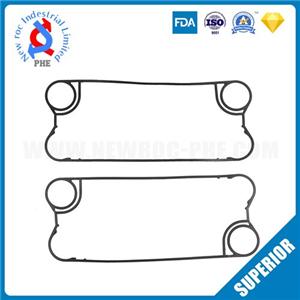Basic characteristics of plate heat exchanger
The structure of plate heat exchanger generally includes:1 Fixed pressure plate; 2 fiexible pressure plate; 3 heat exchanger plate; 4 heat exchanger gasket; 5 top guide bar; 6 bottom guide bar; 7 back post; 8 clamp bolts.
Plate heat exchangers are ideal equipment for liquid-liquid and liquid-vapor heat exchange. It has the characteristics of high heat exchange efficiency, low heat loss, compact and light structure, small footprint, convenient installation and cleaning, wide application range, long service life and so on. Under the same pressure loss, the heat transfer coefficient of the plate heat exchanger is 3-5 times higher than that of the tube heat exchanger, the floor area is 1/3 of the tube heat exchanger, and the heat recovery rate is as high as 90%. The disadvantage is that the pressure is below 3.0Mpa and the temperature does not exceed 200°C. Plate heat exchangers are widely used in metallurgy, petroleum, chemical, food (milk high-temperature sterilization), pharmaceutical, shipbuilding, textile, paper and other industries for heating. Excellent equipment for cooling, heat recovery, and rapid sterilization.
The heat exchanger plate types of the plate heat exchanger can be divided into: deep corrugated heat exchanger plates and shallow corrugated heat exchanger plates, each with a large angle heat exchanger plate (more than 90 degrees is generally 120 Degrees) and small-angle heat exchanger plates (less than 90 degrees is generally 60 degrees). The heat exchanger plates with large and small angles are mainly used to adjust the resistance drop of the plate heat exchanger. In the case of the same type and the same area of the heat exchanger plates, the resistance drop of the large-angle heat exchanger plates is smaller than that of the heat exchanger plates. The resistance of the angle heat exchanger plates is much lower. In order to better meet the needs of customers for resistance reduction, we can consider what kind of angle to use when designing, and if necessary, we can mix and install the large and small angle heat exchanger plates.
Because different liquid (gas) media are corrosive to certain materials, heat exchanger plates made of corrosion-resistant metals or other materials are produced. For example: stainless steel heat exchanger plates can be used for water turbid media; titanium plates or titanium-palladium alloy heat exchanger plates are required for sea water, brine, and chloride-containing ionic liquids; nickel heat exchanger plates for dilute alkali sulfate solutions; Hastelloy heat exchanger plates for sulfuric acid, phosphoric acid, hydrochloric acid, etc.




